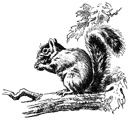Niche - Teacher's Guide |
Episode Overview In segment one, Patrice looks at how all organisms have their own role, or niche in their environment. Next, Patrice and Dave look at the niche of the pileated woodpecker. Then we take an up-close look at coral reef and the niches they fill in the ocean. Finally, Von and Marshall spend the day with conservation officer Joe Giarrusso and learn how he's trying to control the impact of beavers in urban areas. In segment one, Patrice looks at how all organisms have their own role, or niche in their environment. Next, Patrice and Dave look at the niche of the pileated woodpecker. Then we take an up-close look at coral reef and the niches they fill in the ocean. Finally, Von and Marshall spend the day with conservation officer Joe Giarrusso and learn how he's trying to control the impact of beavers in urban areas.
Program ObjectivesStudents will:1. Understand that environments support a diversity of living organisms that all share limited resources. 2. Identify and describe the roles of various organisms in an environment. 3. Predict what would happen if a species was removed from an environment. 4. Recognize the distinct characteristics of the beaver. 5. Describe the beaver in relationship to its niche in a community. Vocabulary
Previewing ActivityBrainstorm jobs that people have in the community. Discuss with the students how those jobs are important to the health of the community. What skills are needed to perform the jobs, what tools and resources do people who do those jobs need, how many of those jobs are in the community, what people do they depend on to do their jobs, what factors might impact their ability to do their jobs. | Post-Viewing Activities1. Have the students generate a list of animals. Next have them identify the niche the animal has in the community. Asks the students to identify what adaptations the animal has that helps it fill its niche, what organisms depend on the animal, what organisms does the animal depend on to fill its niche, what factors might impact its ability to fill its niche an so forth. 2. Have students interview someone about their job, asking the types of questions that were asked in the previewing activity, and write a job profile with the information they gather. 3. Have students research an organism and write a "job description" for that organism. Hands-On: What's My Role?Materials Needednature journalProcessTake a nature walk with the students and have them observe animals and plants and record the role or niche they fill in their community. For example, the grass holds down the soil and provides food and shelter for animals. The squirrel spreads seeds. The woodpecker eats insects. When the students return to class, have each of them select an organism they observed. Then have the students describe the niche of the organism to the rest of the class and see if the class can identify the organism.
|
